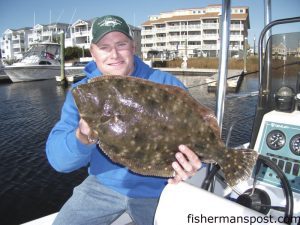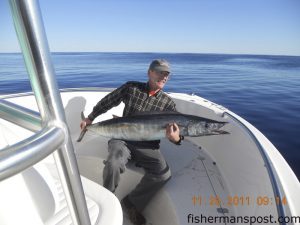Carolina Beach December 15, 2011

Zach Woody, of Raliegh, with a 5.2 lb. flounder that bit a white Gulp shrimp in the Carolina Beach yacht basin. Weighed in at Island Tackle and Hardware.
Wes, of Island Tackle and Hardware, reports that anglers are still seeing some solid speckled trout action in the Carolina Beach boat basin and to the south in the Cape Fear River. There are still some straggler specks in the inlet, but that bite has slowed a bit. Live shrimp are top choices for the specks, but artificials like soft plastics and MirrOlures will produce action with the specks when anglers can’t secure the shrimp.
Surf anglers should continue to see some action with sea mullet and black drum over the next few weeks, and both will respond well to fresh shrimp on bottom rigs.
Out in the ocean, anglers are encountering gag grouper at bottom structure within 20 miles of the beach, but big numbers of ravenous black sea bass are making it tough to get a bait to the grouper. Anglers looking to bring home a few more grouper before the season closes on January 1 would do well to make it out to spots in the 30 mile range, where the sea bass are a little less prevalent and anglers have shots at scamp and red grouper in addition to the gags. Live baits offer anglers the best odds of connecting with the groupers.
Not many recreational anglers have been king mackerel fishing lately, but the commercial fleet has been catching them around 40 miles out. The kings should be wherever temperature breaks lead to water in the mid to upper 60’s and anglers can find bait. Live baits are tough to get this time of year, but dead cigar minnows and Drone spoons will also produce results.
Anglers making the run to the Gulf Stream have found some action with wahoo and blackfin tuna recently. Both fish will be available all winter as long as the Gulf Stream is bringing warm water over the break in 180-220’ of water. Ballyhoo rigged under skirted trolling lures and artificials like Black Barts and cedar plugs will tempt bites from the ‘hoos and blackfins.

Harry T. Fisler, of Burgaw, NC, with a wahoo that bit a ballyhoo under a blue/white Blue Water Candy Mini Jag near the Blackjack Hole.
Ryan, of Carolina Beach Bait and Tackle, reports that surf casters are connecting with some speckled trout in the sloughs and holes off Carolina and Kure beaches and Fort Fisher. MirrOlures (particularly the 808 and Purple Demon colors) have been producing the majority of the fish.
Sea mullet are also feeding just off the beaches. They’ll bite fresh shrimp, but sand fleas are far more effective. The fleas are getting tougher to find, but searching on sunny days around pier pilings and rocky beachfront structure will offer anglers the best odds of loading up.
Jeff, of Seahawk Inshore Fishing Charters, reports that the speckled trout bite in the lower Cape Fear River has been solid lately (producing both good numbers and some quality fish). Deeper, moving water in the creeks and around hard structure is where to look for the specks, and soft baits like Gulps, D.O.A. shrimp, and curlytail grubs will tempt them to bite. The trout action should remain consistent for another few weeks at least, longer if the temperatures stay reasonably mild.
Plenty of red drum are also feeding in the creeks and bays off the lower river. Some large schools have been working the flats in the bays, and there have also been plenty of fish in the creeks. The reds have been skittish lately, so a stealthy approach with a trolling motor or push pole is the only way to get within casting range of them. As the water temperatures fall, the reds will school up tighter in the creeks, where anglers can find them all winter long. Paddletail soft plastics and Gulp baits are top choices for the wintertime reds.
Robert, of Carolina Explorer, reports that anglers are finding some solid red drum action in the backwaters off the lower Cape Fear. The fish are feeding in the bays and creeks, where they’ll be all winter long. Gulp minnow and shrimp baits are the way to go for the reds, although live mud minnows will also produce solid results.

Josie Garner, of Seagrove, NC, with her first red drum, a 25" fish that bit a sand flea in the Carolina Beach Surf. Photo courtesy of Island Tackle and Hardware.
Speckled trout are also feeding in the inlets and around oyster rocks, drop-offs, and deeper holes around Carolina Beach and in the Cape Fear River. MirrOlures have been very effective on the trout lately. Anglers are still seeing plenty of bait around in the river, so the drum and trout action should hold up for quite some time.
Sea mullet are feeding in deeper holes in the lower river and will provide fast action for anglers dropping shrimp and cut mullet on two-hook bottom rigs.
